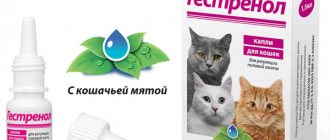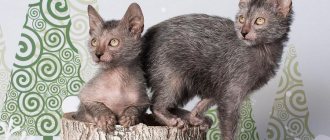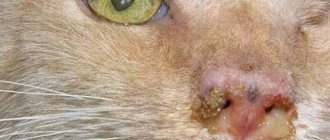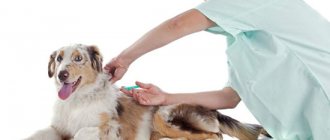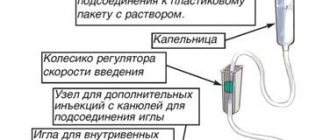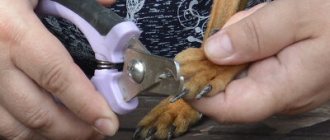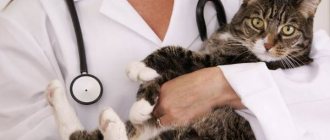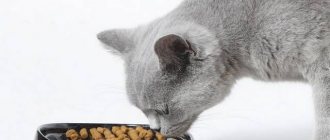Infectious diseases: symptoms and treatment
Cats often become infected with infections caused by various pathogens. In general, infectious pathologies are viral, bacterial and fungal in nature. Why do they arise? They can become infected through airborne droplets, through contact with a sick animal or its belongings. To determine the type of pathogen, laboratory analysis is required. Based on the results of the study, treatment is prescribed under the supervision of a veterinarian.
Viral infections
Viral pathologies are the most common in cats. The most dangerous disease is panleukopenia (feline distemper). With this pathology, the animal’s gastrointestinal tract is affected, the level of leukocytes decreases, as a result of which the body cannot fight the infection. Panleukopenia manifests itself in the form of vomiting, diarrhea, fever, decreased appetite, and constant thirst. Infection occurs through the feces of a sick animal. Treatment is prescribed by a veterinarian. Typically, antiviral agents and immunomodulators are prescribed for feline distemper.
Another dangerous viral disease of cats is calcivirus. Infection occurs by airborne droplets and through care items and clothing. Symptoms:
- decreased appetite;
- elevated temperature;
- discharge from the nose and eyes;
- bad breath;
- ulcers on the tongue, lips, gums, nose;
- lethargy;
- with brain damage - convulsions, incoordination of movements.
Treatment of a cat includes symptomatic therapy, as well as the use of antiviral agents, immunostimulants, and vitamins. In the chronic form of calcivirosis, there are no pronounced symptoms, but with a decrease in immunity, the disease worsens.
Rabies
Rabies is an incurable disease. It manifests itself in the form of changes in the animal’s behavior (obsessive affection, aggression or depression), excessive salivation, difficulty swallowing, and constant itching at the site of the bite. Rabies can occur in a latent form for 1 year.
Diseases of bacterial origin
If the infection is caused by the activity of pathogenic bacteria, it is called bacterial. The most common pathologies are salmonellosis and hemobartenellosis (infectious anemia). Symptoms of salmonellosis are especially pronounced in young animals. The pathology is accompanied by an increase in body temperature (up to 41°C), refusal to eat, vomiting, and diarrhea. The cat may experience convulsions, sometimes there is blood in the stool, and pus is discharged from the eyes and nose. A sick animal should be isolated from other pets and children and taken to a veterinarian as soon as possible.
Infectious anemia occurs against a background of decreased immunity, especially in pregnant cats and animals suffering from any pathology. Symptoms: weakness, weight loss, yellowish tint of mucous membranes, swelling in the lower part of the body. A bacterial infection is treated with antibiotics, and symptomatic therapy is also necessary.
Fungal infections
Ringworm
The most common fungal infection is ringworm. It appears in the form of pinkish bald spots, grayish scabs, similar to dandruff. Itching occurs in the affected area. The disease is especially dangerous for kittens aged 1–3 months.
Ringworm is contagious and can be transmitted from animal to person, so when treating your pet you must use gloves, a mask, and a gown. Treatment of mycoses involves the use of external agents (ointments, sprays). In advanced cases, antifungal medications may be required.
Consequences
If, when the first signs of the disease are detected, the owner does not begin timely treatment, then possible complications of rhinotracheitis in kittens may appear. The dangerous consequences of this disease include the following:
- Bronchitis and inflammation of the lungs (pneumonia) often occur;
- Severe damage to the nervous system occurs. This condition may be accompanied by stiffness of gait, muscle tremors, twitching of the limbs;
- Damage to the gastrointestinal tract may occur - constipation, intestinal weakness, diarrhea, diarrhea;
- Manifestation of regular secondary infectious processes;
- The development of leukemia and viral immunodeficiency is observed. In these cases, the mortality rate is 100%.
Find out more about the treatment and prevention of rhinotracheitis in cats in adulthood.
Parasitic lesions
Worm infestations, infection with ticks, fleas and protozoa are considered parasitic diseases.
To prevent most parasitic pathologies, it is necessary to carry out regular deworming and use means of protection against ectoparasites (drops, collars, etc.). Infection with protozoa requires medical treatment.
Worm infestation
Helminths are worms that settle in the bodies of mammals and parasitize them. A cat can become infected with worms through grass, soil, food (especially raw fish and meat), water and even air. Helminthiasis is transmitted from mother to newborn kitten; it can also be acquired through contact with an infected animal. Symptoms of helminthic infestation:
- abdominal enlargement;
- gastrointestinal disorder;
- hair loss;
- itching in the anal area.
In severe cases, there may be blood in the stool, copious discharge from the nose and eyes, intoxication up to paralysis of the hind limbs. Kittens at about 2 months of age develop anemia and developmental delays. The pathology should be treated with anthelmintic drugs in the form of tablets, suspensions or drops for external use.
Protozoa infection
Many cats and cats are infected with toxoplasmosis, a disease caused by single-celled microorganisms. Often the pathology occurs without visible manifestations, but an acute form is also possible. Signs of toxoplasmosis: fever, vomiting, diarrhea, blurred vision, enlarged lymph nodes. If the cat is sick, the use of Clindamycin is required; if uveitis develops, one percent prednisone is required. Treatment should be stopped only 14 days after symptoms disappear.
Ectoparasites (ticks, fleas, etc.)
Infection with fleas, lice-eaters, and ticks occurs when preventive measures are not followed. A pet can pick up the parasite while walking, or through contact with rodents or infected cats. If there are ectoparasites, the cat becomes restless, itches, and black dots can be seen on the fur - insect excrement, or the insects themselves. You can treat your animal at home using external means (drops, sprays). If a tick is found, you should immediately contact a veterinarian.
Use of folk remedies
A list of folk recipes will help you remove worms from a cat.
Some owners are afraid to use drugs with toxins to remove worms. They prefer folk remedies. Among them:
- alcohol tincture of wormwood (10 drops twice a day an hour before meals);
- enema with carrot juice (20 ml per day);
- instead of regular water, give the animal a decoction of chamomile or fennel;
- onion solution: pour boiling water over regular onion and leave. Use only on an empty stomach;
- tansy flowers in the form of a brewed infusion (three times a day an hour before feeding);
- Garlic has been used for a long time as a means of preventing worms.
What diseases are common in cats after sterilization?
Sterilizing cats in some cases can lead to unpleasant consequences. Such pets are predisposed to certain diseases, especially if the owners do not comply with preventive measures (post-operative care for the animal, correction of the cat’s diet and lifestyle). Diseases often found in sterilized animals are presented in the table:
| Disease | Symptoms | Treatment |
| Hernia | Intestinal loops or parts of internal organs become trapped in the subcutaneous sac, causing the pet to experience pain. On palpation, a soft lump (or several) is felt. | Surgical. |
| Urolithiasis disease | Painful and frequent urination, the pet does not have time to reach the litter box. There may be blood in the urine. | The use of medicinal and homeopathic drugs, shock wave therapy, nutrition correction. In severe cases, surgery is necessary. |
| Obesity | Excess weight gain, low physical activity. | Correction of diet and lifestyle. |
The consequences of sterilization can be both short-term and long-term. Short-term ones are related to the quality of the operation performed and compliance with the veterinarian’s recommendations during the rehabilitation period. Long-term (ICD, obesity) are the result of the loss of the animal’s sexual instinct and hypoactivity.
What to feed a cat with ICD
When treating a cat for urolithiasis, be sure to use special food for cats with urolithiasis. They have a balanced composition of nutrients, minerals and vitamins. The type of cat food is chosen depending on what stones have formed in the genitourinary system. Natural nutrition is selected individually, but in any case it is recommended to avoid seafood and dairy, as they are saturated with mineral salts.
Diet for oxalate stones
Food should contain a minimum of oxalic acid. If the pet is on homemade food, then offal (liver, kidneys), as well as dairy dishes containing a lot of calcium, should be temporarily excluded. The therapeutic diet includes meat, vegetable stew made from cauliflower, carrots, beets and pumpkin, and rice porridge. If you buy ready-made food for your cat, you need to carefully choose the variety. For oxalate stones, the following is suitable for a cat:
- Hill's Prescription Diet Feline K/D or X/D
- Royal Canin URINARY
- Eukanuba Oxalate Urinary Formula
Hill's Prescription Diet Feline X/D. It has a reduced concentration of calcium and phosphorus, but an increased amount of potassium citrate and soluble fiber. This dietary food should not be fed to pregnant cats, young kittens or cats with struvite crystallization. Hill's Prescription Diet Feline brand K/D is used for stones of any nature.
Royal Canin URINARY is used for both therapeutic and preventive nutrition. It increases urine output and inhibits the formation of stones. The food has limitations - high blood pressure and abnormalities in kidney function.
Eukanuba Oxalate Urinary Formula is a low-calorie dietary food with reduced calcium and fat content. Ingredients are chicken, turkey, egg, cornmeal. Wet food comes with fish. Contraindications include pregnancy, lactation, and under one year of age.
Diet for struvite
Phosphate stones, which form in an alkaline environment, require a change in pH to the acidic side. This is partly facilitated by medicinal food or a properly selected diet of natural products. The cat should not be fed dairy products (cottage cheese, cheese, milk), or egg yolks. It is recommended to prepare dishes from oatmeal, rice, liver, egg whites, lean beef and veal. An alternative could be:
- Hill's Prescription Diet Feline S/D, C/D
- Eukanuba Struvite Urinary Formula
Hill's Prescription Diet Feline S/D is a medicinal food that fully meets the nutritional requirements of this category of cats. The composition contains meat, chicken fat, rice, corn flour, starch. This food should not be offered to small kittens under one year old or pregnant cats.
Eukanuba Struvite Urinary Formula. It is used for struvite crystallization and tendency to fullness. Dry granules are made from corn grits, chicken, turkey, animal fat, and dried eggs. This variety is not given to pregnant and lactating females and small kittens.
Diseases common in kittens
For small cats, any disease is dangerous, so it is important to cure it in time. Kittens often suffer from bronchitis, discopathy (compression of the spinal cord as a result of birth trauma to the spine), conjunctivitis, and panleukopenia.
To avoid the development of the disease, you need to create comfortable living conditions for newborn kittens and their mother. The birth process must be supervised by a veterinarian, and the mother cat must be cured of existing diseases even before pregnancy. All animals are recommended to have their vaccinations on schedule. In this case, frequent illnesses in kittens will not occur in babies.

